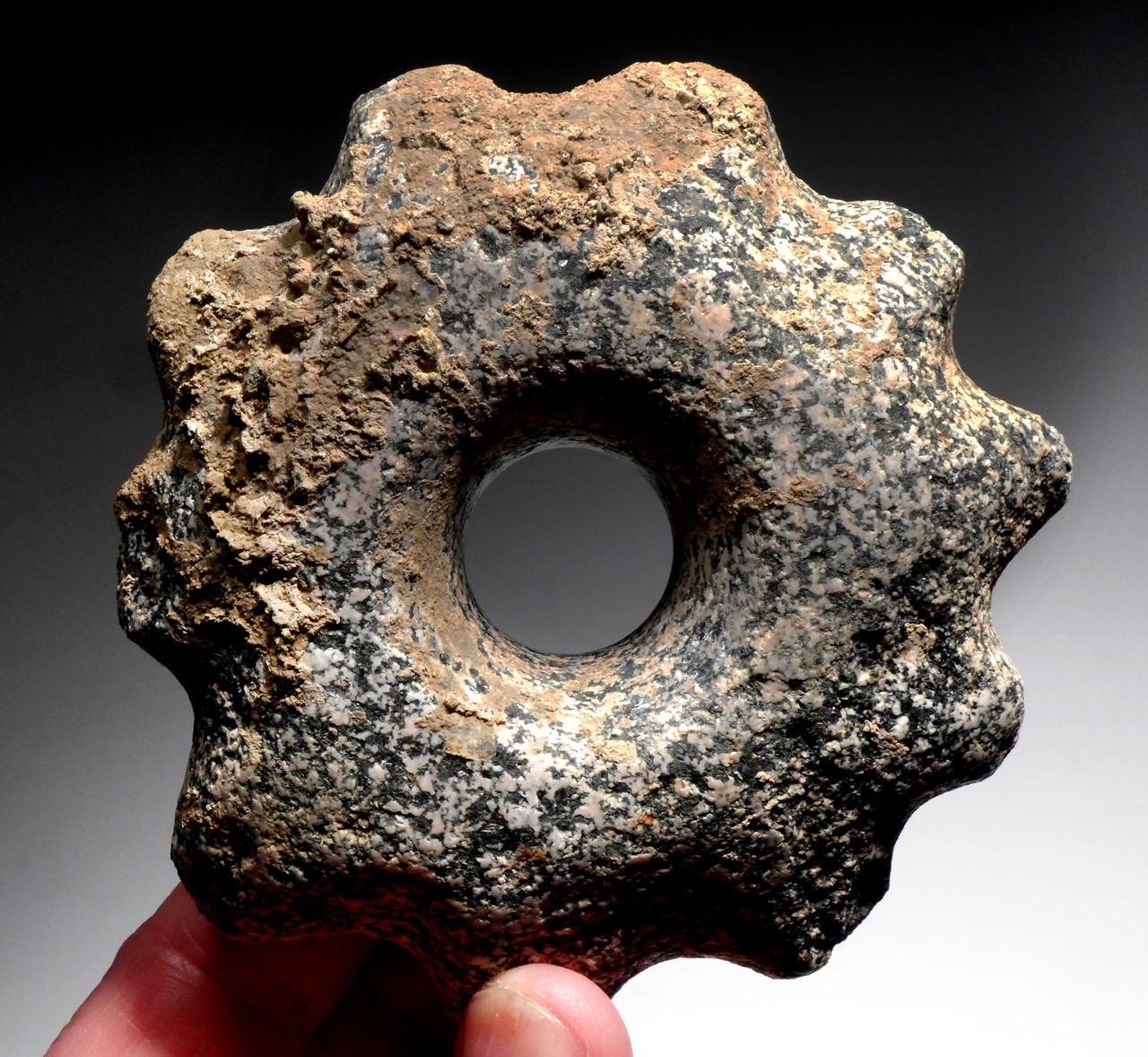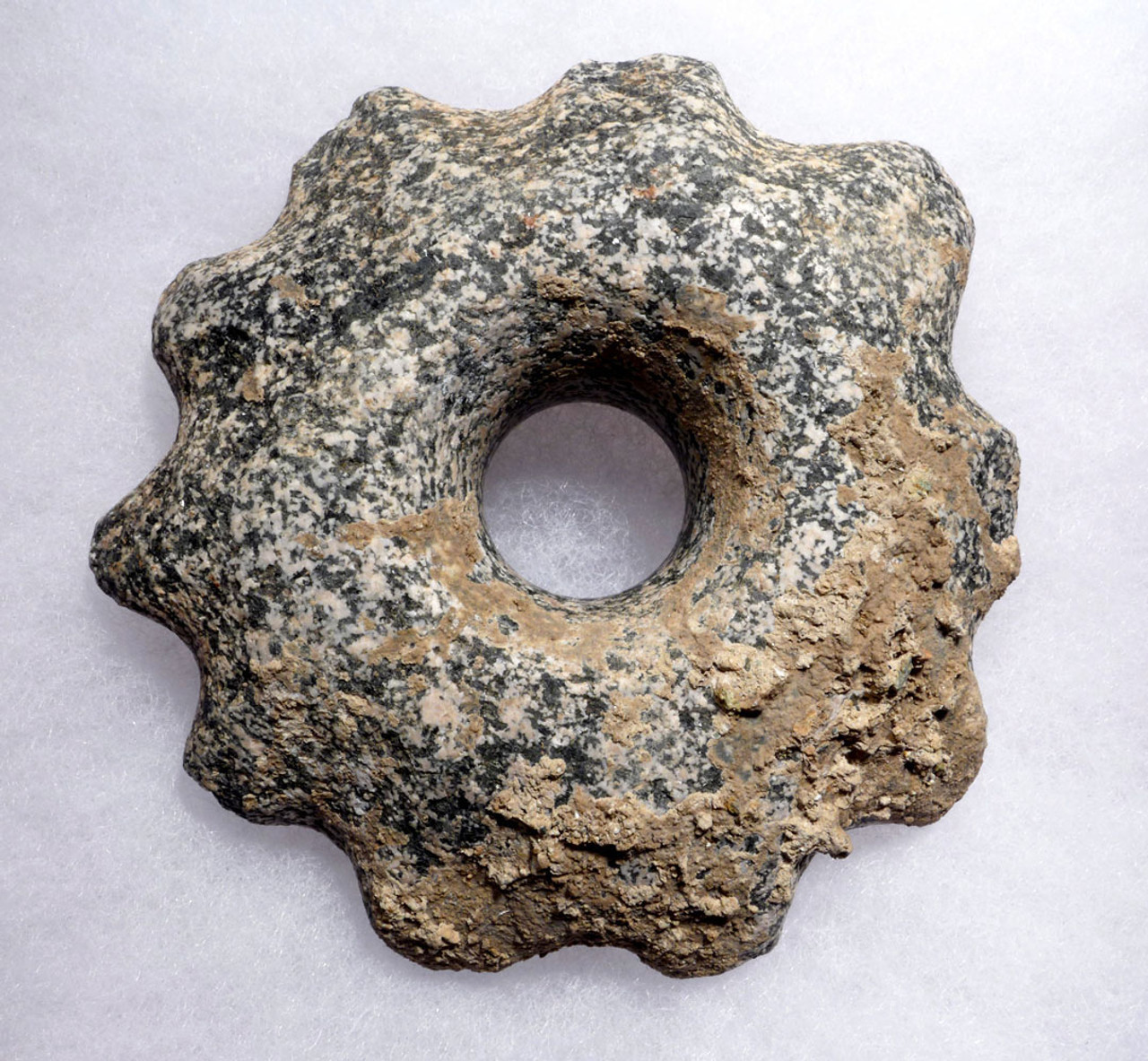Product Description
SEE MORE ANCIENT NEAR EASTERN ARTIFACTS
Ground out of diorite and perforated in the center to mount onto a robust wooden handle, this star knobbed stone disk mace comes from the ancient Assyrian Empire of the Near East. It dates back to a period spanning the Old to Early Assyrian periods. While most stone maces of this region were simple globular shapes, some very rare example like this in the early periods, were knobbed disk forms. Ancient Assyrian Empire objects are extremely rare of any type but a stone mace of this form from ANY Ancient Near Eastern civilization is extremely rare although, not unknown. A more refined and later period Assyrian knobbed disk mace can be seen in the Istanbul Museum of the Ancient Orient here.
This knobbed disk star mace shows evidence of ancient combat use in some of knobs having impact damage and wear. The size of the perforated central hole shows this would have been mounted to a robust wooden shaft handle, likely reinforced with a bronze tube over the wood. This unbroken perforated disk mace head has a slightly upturned but rounded edge with radial protruding knobs giving it a star shape. It would have been employed by foot soldiers and later, by mounted warriors on horseback and chariot. Heavy calcite deposits on the surfaces testify to its extreme age. Stone disk maces like these were the first mace heads ever used, later to be replaced with copper and bronze as the later Bronze Age would usher in.
This Assyrian war mace was an important weapon used during the time when societies were developing, and warfare between groups and city-states, was increasing. Tools and weapons from this region and time are very scarce and this is one of the very few objects we will ever have to offer of its kind.
Maces were used in combat both on foot, and in chariots and horseback in Neolithic and Ancient cultures from the Near East. This weapon was most effective on unarmored or lightly armored foes. Upon the advent of bronze, bronze armor and helmets became commonly worn during combat and as a result, the stone mace became much less effective as the stone heads shattered upon impact with the metal armor.
HISTORY
Assyria was a major ancient Mesopotamian civilization which existed as a city-state from the 21st century BC to the 14th century BC, then to a territorial state, and eventually an empire from the 14th century BC to the 7th century BC. The great cities of the Assyrian Empire included Ashur, Nimrud, and Nineveh. Ashur was the capital of the original empire and also their main god. At its peak, the Assyrian empire stretched from Cyprus in the Mediterranean Sea to Persia, and from the Caucasus Mountains (Armenia, Georgia, Azerbaijan) to the Arabian Peninsula and Egypt. It was at the height of technological, scientific, and cultural achievements for its time. In the Old Assyrian period, Assyria established colonies in Asia Minor and the Levant, and asserted itself over southern Mesopotamia under king Ilushuma.
According to one interpretation of passages in the biblical Book of Genesis, Ashur was founded by a man named Ashur son of Shem, son of Noah, after the Great Flood, who then went on to found the other important Assyrian cities. A more likely account is that the city was named Ashur after the deity of that name sometime in the 3rd millennium BCE; the same god's name is the origin for 'Assyria'. The biblical version of the origin of Ashur appears later in the historical record (Genesis is dated to c. 1450 BCE at the earliest, 5th century BCE latest) and seems to have been adopted by the Assyrians after they had accepted Christianity.
Assyria became a great military power during the Neo-Assyrian period, and saw the conquests of large empires, such as Egyptians, the Phoenicians, the Hittites, and the Persians, among others.
 US DOLLAR
US DOLLAR
 EURO
EURO
 AUSTRALIAN DOLLAR
AUSTRALIAN DOLLAR
 CANADIAN DOLLAR
CANADIAN DOLLAR
 POUND STERLING
POUND STERLING


















